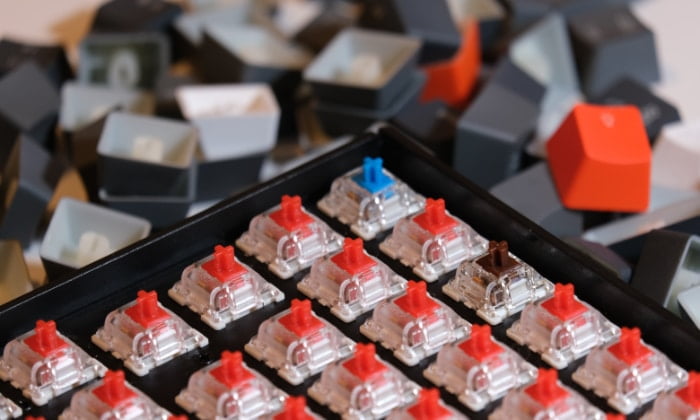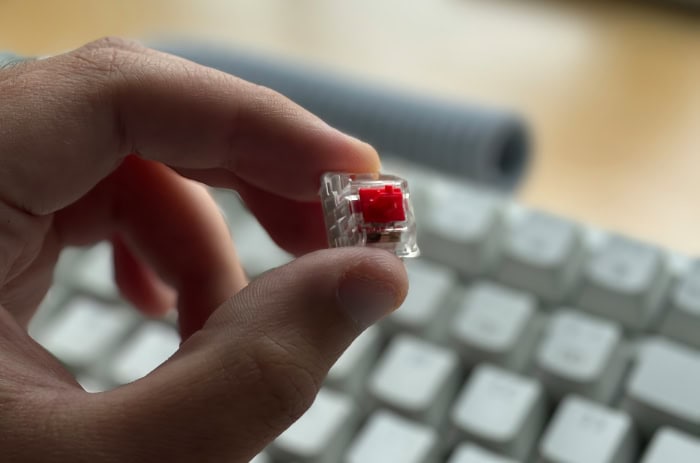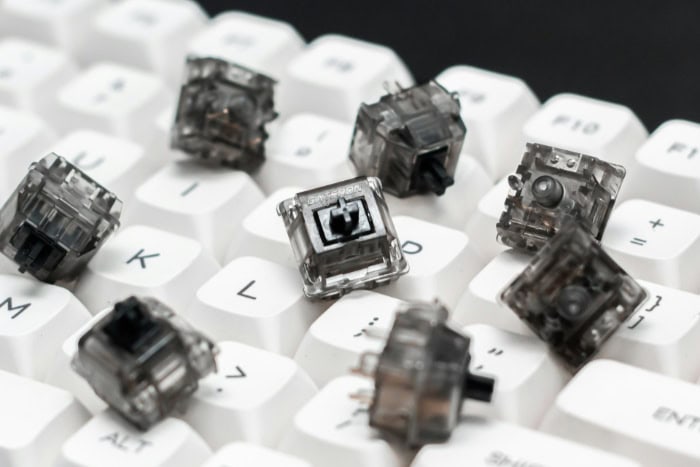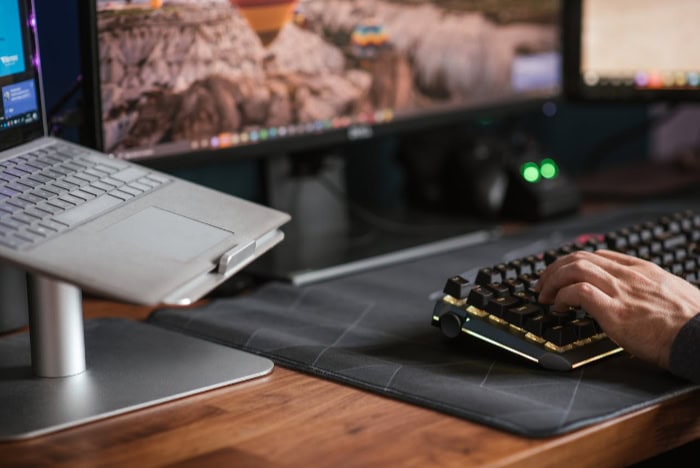Linear vs. Tactile: Which Switch Is Right for You?

Mechanical keyboards offer an unmatched level of customization, letting users tailor their typing or gaming experience to their preferences. One of the most important decisions when choosing a mechanical keyboard is selecting the right type of switch.
Linear and tactile switches are two of the most popular options, each offering a unique feel, sound, and typing experience. Linear switches provide a smooth and uninterrupted keystroke, while tactile switches offer a noticeable feedback bump.
Choosing between the two can greatly influence comfort and performance, making it essential to understand their differences.
Keystroke Feel and Feedback
The feel of a keyboard switch is one of the most significant factors in determining how enjoyable and efficient typing or gaming will be.
Linear and tactile switches offer distinctly different experiences in this regard, each catering to specific preferences based on how the keystroke feels and how much feedback is provided during use.
Linear Switches
Linear switches are known for their smooth and consistent keystroke from the moment you press the key down to when it bottoms out. This means there is no noticeable change in resistance or interruption during the keypress.
The absence of a tactile bump makes the switch feel very fluid, allowing for a seamless keypress from top to bottom.
This type of switch is often favored by users who prefer a keystroke that doesn't provide any feedback other than the key reaching the bottom of its travel.
Without a tactile bump or click, users may not always know when the key has actuated (registered a press) until it reaches the end of the stroke.
This lack of interruption is particularly appealing in fast-paced gaming, where rapid key inputs are crucial, and users don't want any resistance slowing them down.
However, for typists or those who rely on feedback, this lack of tactile sensation might feel less precise.
Since there is no bump or click to indicate when the keypress has been registered, some users may find themselves bottoming out the keys more often, which can lead to finger fatigue over time, especially during extended typing sessions.
Tactile Switches
Tactile switches, on the other hand, offer a distinct bump at the actuation point—typically about halfway through the keypress. This bump provides a form of feedback, letting the user know that the key has been actuated without the need to press it all the way to the bottom.
The tactile sensation is subtle but noticeable, giving users a clear indication that their input has been recognized.
This feedback is particularly useful in typing scenarios, where accuracy is often more important than speed. The tactile bump helps users avoid bottoming out the key, allowing for faster typing with less force, as they can release the key once they feel the bump.
This can reduce strain over long typing sessions and improve overall typing speed for users who prefer not to press keys all the way to the bottom.
Unlike their clicky counterparts, tactile switches aren't typically noisy, but the bump can create a slight sound that some users find satisfying.
However, this sound and sensation might not appeal to those who prefer the smoothness of linear switches, especially in situations where rapid key presses are required.
Sound Profile

The sound profile of a mechanical switch is another critical factor that can influence a user's choice. Some prefer a quiet typing experience, while others enjoy the audible feedback of each keypress.
Linear and tactile switches differ notably in how much noise they produce, making them suitable for different environments and personal preferences.
Quietness of Linear Switches
Linear switches are generally considered quieter compared to both tactile and clicky switches. This is primarily due to their design, which lacks the tactile bump or any clicking mechanism that would otherwise generate additional noise.
When pressed, linear switches move smoothly from the top of the stroke all the way down, meaning the only sound produced is from the key bottoming out or the keycap returning to its original position.
For users who are sensitive to noise or find themselves frequently typing in shared or quiet environments, such as offices, libraries, or late-night gaming sessions, linear switches can be a great option.
The absence of a tactile bump not only reduces the sound of the keypress itself, but also encourages a softer typing style. The smoothness of the keystroke means users can avoid bottoming out the key hard, further minimizing noise.
That said, it's worth noting that linear switches aren’t completely silent. Sounds can still be produced by the keycap hitting the keyboard plate or by the switch spring, but these noises are generally much less pronounced than those of tactile or clicky switches.
For those seeking an even quieter experience, some manufacturers offer “silent” linear switches, which incorporate dampeners to further reduce the noise during keypresses.
Auditory Feedback in Tactile Switches
Tactile switches, while quieter than clicky switches, still produce some noise due to the tactile bump. This bump, which occurs at the point of actuation, creates a slight sound as the switch mechanism shifts to register the keypress.
While this sound is not as loud as the distinct “click” found in clicky switches, it is more noticeable than the near-silent operation of linear switches.
For users who enjoy a bit of auditory feedback but don't want something as loud as a clicky switch, tactile switches strike a balance. The noise generated by the tactile bump can be satisfying to the user, providing both a physical and auditory cue that the keypress has been registered.
This can make typing feel more engaging and can help some users maintain a rhythm when typing or gaming.
However, the sound produced by tactile switches may not be ideal for noise-sensitive environments. In quieter settings, such as open-plan offices or shared workspaces, the slight noise created by the tactile bump could potentially be distracting to others.
While the sound is not overwhelming, it can still be significant enough to be noticed, particularly when multiple keys are pressed in succession during rapid typing or gaming.
Best Use Cases: Gaming vs. Typing

Choosing the right switch can greatly enhance performance and comfort based on the task at hand. Linear and tactile switches each excel in specific scenarios, whether it’s competitive gaming or long hours of typing.
Gaming with Linear Switches
Linear switches are often the go-to choice for gamers, particularly those who value speed and precision in their gameplay.
The smooth, uninterrupted keystroke that linear switches provide allows for rapid key presses without any resistance or tactile bump slowing down the action.
This makes them ideal for games where quick reflexes and fast inputs are essential.
One of the primary reasons linear switches are favored in gaming is their fast actuation. Since there is no tactile bump to overcome, users can press keys swiftly and repeatedly without the added resistance found in tactile switches.
This can be especially beneficial in first-person shooter (FPS) games, where rapid keystrokes are required for actions like strafing, jumping, or firing weapons.
In fast-paced genres such as battle royales, MOBAs (multiplayer online battle arenas), or rhythm games, the lack of interruption translates into faster response times and a smoother overall experience.
Additionally, linear switches are often praised for their consistency. Every key press feels the same from start to finish, allowing gamers to develop muscle memory and execute complex combinations of movements without distraction.
The smoothness of the switches also helps reduce finger fatigue during extended gaming sessions, as players don't need to exert extra force to overcome a tactile bump.
For gamers who prioritize speed, fluidity, and precision, linear switches offer a clear advantage, especially in competitive settings where every millisecond counts.
Typing with Tactile Switches
While linear switches may dominate in the gaming world, tactile switches are often preferred by those who spend long hours typing. The tactile bump that characterizes these switches provides a form of feedback that can greatly improve typing accuracy and comfort.
This bump occurs at the point of actuation, signaling to the user that the keypress has been registered without the need to press the key all the way down to the bottom.
This feedback is particularly useful for typists, as it allows for more controlled keypresses. Instead of bottoming out on every keystroke, users can release the key once they feel the bump, which can reduce strain on the fingers and improve typing speed.
The tactile sensation also helps typists maintain a more consistent rhythm, as the actuation point becomes a natural indicator that the keypress has been successful. This can be especially beneficial when typing long documents or working on tasks that require sustained input over several hours.
Tactile switches are also appreciated by those who prioritize accuracy over speed. The feedback helps minimize typing errors, as users can develop a more precise feel for when each key is actuated.
This makes tactile switches a popular choice among writers, coders, and office workers who spend much of their day typing.
For users who value comfort and accuracy during long typing sessions, tactile switches provide a satisfying balance of feedback and control, making them better suited for productivity-focused tasks.
Actuation Force and Speed

The actuation force and speed of a switch significantly influence how it feels during use. Actuation force refers to the amount of pressure needed to register a keypress, while actuation speed indicates how quickly a keypress is recognized.
These factors can affect both typing comfort and gaming performance, making them important considerations when choosing between linear and tactile switches.
Force Required for Linear Switches
Linear switches are known for requiring relatively low actuation force, making them ideal for users who prefer lighter, faster keypresses. For example, Cherry MX Red switches, one of the most popular linear options, typically require around 45 grams of actuation force.
his light pressure allows for swift, smooth keypresses, enabling rapid inputs without much effort.
The reduced actuation force in linear switches can be particularly beneficial for gamers. In fast-paced gaming scenarios, a lower actuation force means players can press keys with minimal resistance, allowing for quicker responses.
The lighter touch required also helps reduce finger fatigue during extended gaming sessions, where rapid, repetitive keypresses are common.
This ease of use makes linear switches a favorite for gamers who prioritize speed and fluidity in their gameplay, especially in genres like first-person shooters or action games.
However, the low actuation force in linear switches may not appeal to everyone. Some users might find that the lack of resistance makes it easier to accidentally press keys, which can be problematic for those who require more deliberate, controlled typing.
Force Required for Tactile Switches
Tactile switches, such as Cherry MX Brown switches, typically require slightly more actuation force compared to their linear counterparts.
For example, Cherry MX Browns usually require around 55 grams of force to actuate. This added resistance is what creates the tactile bump, providing feedback to the user when the key has been pressed and registered.
The higher actuation force in tactile switches can be helpful for typists, as it promotes more deliberate and precise keypresses. The tactile bump acts as a signal that the key has been actuated, allowing users to release the key without needing to press it all the way down.
This can improve typing accuracy, as users are less likely to make accidental presses due to the additional resistance.
The slightly higher force requirement in tactile switches can also enhance typing comfort during long sessions. By providing feedback mid-press, tactile switches reduce the need to bottom out keys, which can help prevent finger fatigue over time.
However, the increased actuation force may feel slower compared to linear switches, particularly in scenarios where speed is critical, such as gaming or fast typing.
Actuation Speed Comparison
When it comes to actuation speed, linear switches generally have an edge over tactile switches. As mentioned earlier, the smooth keystroke and lower actuation force of linear switches allow for faster inputs, making them better suited for scenarios where quick reactions and rapid keypresses are essential.
Some linear switches, like Cherry MX Speed Silver, are specifically designed for even faster actuation. These switches have a shorter actuation point—meaning the keypress is registered earlier in the stroke—resulting in quicker inputs.
Cherry MX Speed Silvers, for example, actuate at 1.2 mm compared to the standard 2.0 mm actuation point in typical switches. This shorter travel distance can shave milliseconds off each keypress, which can be a significant advantage in competitive gaming.
Tactile switches, while not necessarily slow, tend to have a longer actuation point compared to specialized linear switches. The tactile bump introduces a slight delay as the user feels the feedback before continuing the keypress.
This can make tactile switches feel less responsive in high-speed scenarios, although the feedback they provide improves accuracy and precision for typing tasks.
User Preferences and Comfort

When selecting between linear and tactile switches, comfort is a significant factor, especially for users who spend long hours typing or gaming. Each switch type offers a different experience in terms of how it feels during extended use, how it affects finger fatigue, and how easy it is to adapt to.
Comfort Over Extended Use
While linear switches offer a smooth and fast keystroke, they can sometimes lead to finger fatigue during extended typing sessions, particularly if the user frequently bottoms out the keys.
Bottoming out refers to pressing the key all the way down until it hits the keyboard’s base or frame.
Since linear switches don’t provide any tactile feedback along the way, users often press harder than necessary to ensure their keystrokes are registered, which can increase strain on the fingers over time.
This tendency to bottom out is more noticeable during long typing sessions, where users may develop a habit of pressing each key with consistent force, even though less pressure is needed to actuate the switch.
Over time, this can cause discomfort, especially for those who type for hours at a stretch. Gamers, however, may not experience this issue as much, since gaming sessions typically involve rapid key presses but not the same level of sustained, repetitive motion that typing requires.
Tactile Feedback for Comfort
Tactile switches, on the other hand, are designed to provide feedback at the actuation point, which can help users avoid bottoming out.
The tactile bump signals that the key has been pressed far enough for the keystroke to register, allowing the user to release the key without pressing it all the way to the bottom.
This reduces the amount of force needed on each keypress and can help alleviate strain on the fingers, especially during long typing sessions.
For users who prioritize comfort during extended typing, tactile switches may offer a more ergonomic experience. By preventing unnecessary bottoming out, tactile switches can reduce finger fatigue and promote a lighter typing style.
This makes them a popular choice for those who spend a lot of time typing, such as writers, coders, or office workers.
However, while tactile feedback can improve comfort for typing, it may feel slower or less fluid for certain gaming scenarios compared to linear switches.
Gamers who prefer continuous, rapid keypresses might find the tactile bump interrupts their flow, leading to a preference for the smoother keystrokes offered by linear switches.
Learning Curve
Another factor to consider is the adjustment period when switching from membrane keyboards or other switch types to mechanical keyboards. Membrane keyboards, which are commonly used in many standard office keyboards, have a very different feel compared to mechanical switches.
Users transitioning to mechanical keyboards may find linear switches more challenging to adapt to, as the lack of tactile feedback can make it harder to gauge when a keypress has been registered.
For beginners, tactile switches tend to be more intuitive. The feedback provided by the tactile bump makes it easier to determine when a keypress is actuated, which can help users adjust more quickly.
The sensation of knowing when the key has been pressed is similar to what many users experience with membrane keyboards, where a distinct change in pressure occurs as the key is pressed.
For users who are new to mechanical keyboards or who are switching from membrane keyboards, tactile switches may provide a more familiar and comfortable experience during the initial transition.
On the other hand, users who are already accustomed to mechanical switches or who prioritize speed and seamless keystrokes may find linear switches more to their liking, despite the learning curve.
Conclusion
Linear and tactile switches each bring unique qualities to the table, catering to different user needs. Linear switches excel in speed and fluidity, making them ideal for gamers who prioritize fast, uninterrupted keystrokes.
Their smooth operation and lighter actuation force allow for quick inputs with minimal resistance, making them perfect for high-speed gaming scenarios.
However, the lack of feedback may lead to finger fatigue during long typing sessions, particularly if users bottom out frequently.
Tactile switches, on the other hand, provide a noticeable bump that enhances typing accuracy and reduces strain by preventing unnecessary bottoming out.
This feedback makes them a popular choice for typists and those who spend extended periods typing, offering a more comfortable and controlled experience.
While they might not be as fast as linear switches for gaming, their emphasis on precision and comfort makes them a strong contender for productivity-focused tasks.
Ultimately, the best switch depends on individual needs, preferences, and primary use cases. Gamers may lean toward the speed of linear switches, while those who type extensively may benefit from the comfort and feedback of tactile switches.


